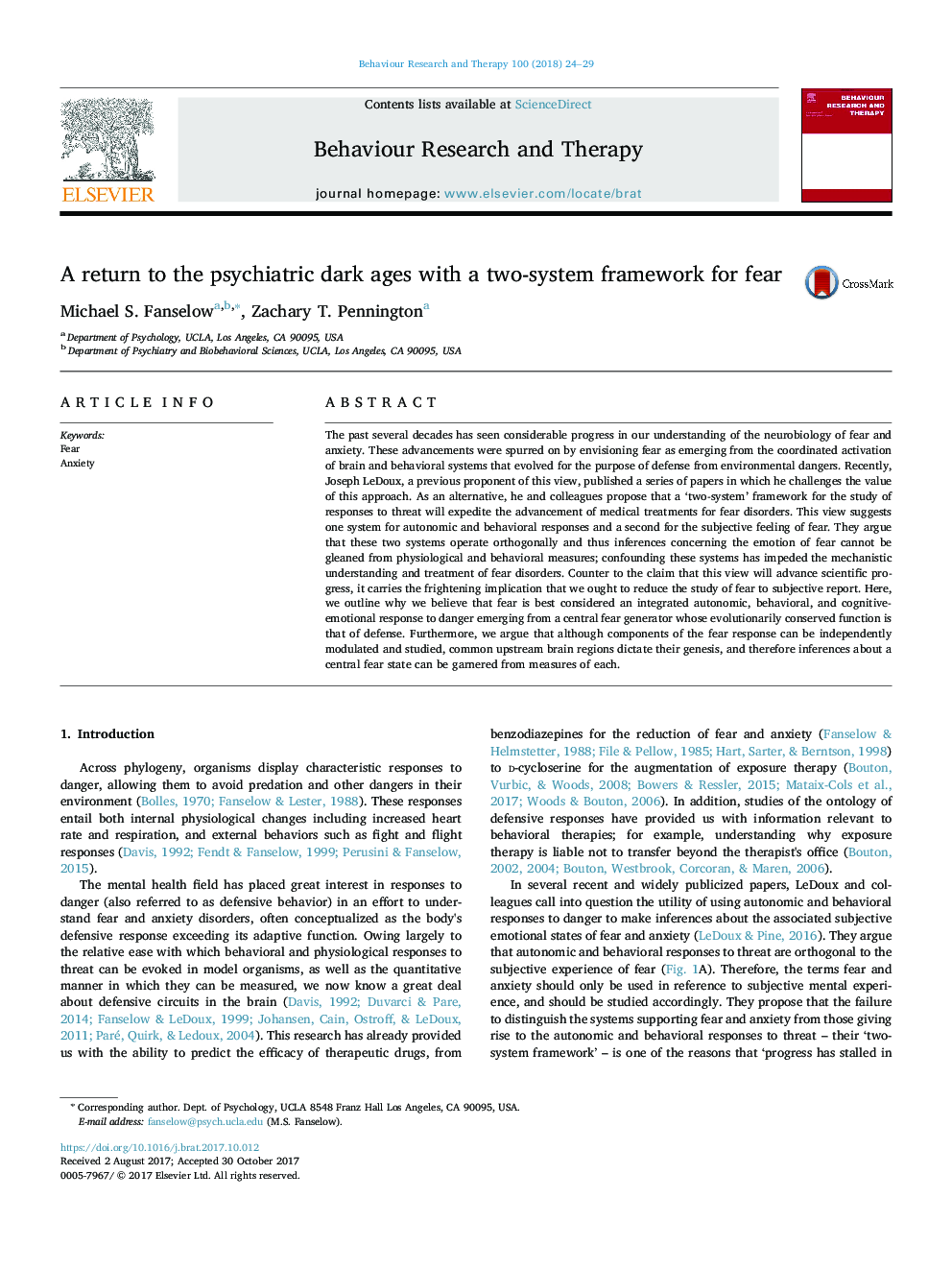| کد مقاله | کد نشریه | سال انتشار | مقاله انگلیسی | نسخه تمام متن |
|---|---|---|---|---|
| 7261940 | 1472749 | 2018 | 6 صفحه PDF | دانلود رایگان |
عنوان انگلیسی مقاله ISI
A return to the psychiatric dark ages with a two-system framework for fear
ترجمه فارسی عنوان
بازگشت به سن تیره روانپزشکی با چارچوب دو سیستم برای ترس
دانلود مقاله + سفارش ترجمه
دانلود مقاله ISI انگلیسی
رایگان برای ایرانیان
کلمات کلیدی
ترس اضطراب،
ترجمه چکیده
چند دهه گذشته پیشرفت قابل توجهی در درک ما از نوروبیولوژی ترس و اضطراب داشته است. این پیشرفت ها به وسیله پیش بینی ترس ناشی از فعال سازی هماهنگ سیستم مغزی و رفتاری که به منظور دفاع از خطرات محیط زیست تکامل یافته بود، تشدید شد. اخیرا، جوزف لوود، یکی از طرفداران پیشین این دیدار، مجموعه ای از مقالاتی را منتشر کرد که در آن ارزش این رویکرد را مورد چالش قرار می دهد. به عنوان یک جایگزین، او و همکارانش پیشنهاد می کنند که یک چارچوب "دو سیستم" برای مطالعه پاسخ به تهدید، پیشرفت درمان های پزشکی برای اختلالات ترس را تسریع خواهد کرد. این دیدگاه یک سیستم را برای پاسخ های رفتاری و اتوکی و یک ثانیه برای احساس ترس از ذهن ارائه می دهد. آنها استدلال می کنند که این دو سیستم به طور مرتب کار می کنند و بنابراین نتیجه گیری های مربوط به احساسات ترس نمی تواند از اقدامات فیزیولوژیکی و رفتاری محو شود؛ مخلوط کردن این سیستم ها مانع درک مکانیسم و درمان اختلالات ترس است. مخالفت با این ادعا که این دیدگاه پیشرفت علمی را پیشبرد می کند، مفهوم ترسناکی دارد که ما باید مطالعه ترس نسبت به گزارش ذهنی را کاهش دهیم. در اینجا ما مشخص میکنیم که چرا ما بر این باوریم که ترس بهتر است به عنوان پاسخ یکپارچه اتانکی، رفتاری و شناختی-عاطفی در معرض خطر از یک ژن ترس مرکزی قرار گیرد که عملکرد تثبیت شده حفظ شده، دفاع از آن است. علاوه بر این، ما استدلال می کنیم که اگر چه مولفه های پاسخ ترس می تواند به صورت مستقل و مدولاسیون شده و مورد مطالعه قرار گیرد، مناطق مشترک مغز بالادست، ژن خود را دیکته می کنند و بنابراین نتیجه گیری های مربوط به یک حالت ترس مرزی می توانند از اندازه گیری هر یک از آنها بدست آید.
موضوعات مرتبط
علوم پزشکی و سلامت
پزشکی و دندانپزشکی
روانپزشکی و بهداشت روانی
چکیده انگلیسی
The past several decades has seen considerable progress in our understanding of the neurobiology of fear and anxiety. These advancements were spurred on by envisioning fear as emerging from the coordinated activation of brain and behavioral systems that evolved for the purpose of defense from environmental dangers. Recently, Joseph LeDoux, a previous proponent of this view, published a series of papers in which he challenges the value of this approach. As an alternative, he and colleagues propose that a 'two-system' framework for the study of responses to threat will expedite the advancement of medical treatments for fear disorders. This view suggests one system for autonomic and behavioral responses and a second for the subjective feeling of fear. They argue that these two systems operate orthogonally and thus inferences concerning the emotion of fear cannot be gleaned from physiological and behavioral measures; confounding these systems has impeded the mechanistic understanding and treatment of fear disorders. Counter to the claim that this view will advance scientific progress, it carries the frightening implication that we ought to reduce the study of fear to subjective report. Here, we outline why we believe that fear is best considered an integrated autonomic, behavioral, and cognitive-emotional response to danger emerging from a central fear generator whose evolutionarily conserved function is that of defense. Furthermore, we argue that although components of the fear response can be independently modulated and studied, common upstream brain regions dictate their genesis, and therefore inferences about a central fear state can be garnered from measures of each.
ناشر
Database: Elsevier - ScienceDirect (ساینس دایرکت)
Journal: Behaviour Research and Therapy - Volume 100, January 2018, Pages 24-29
Journal: Behaviour Research and Therapy - Volume 100, January 2018, Pages 24-29
نویسندگان
Michael S. Fanselow, Zachary T. Pennington,
